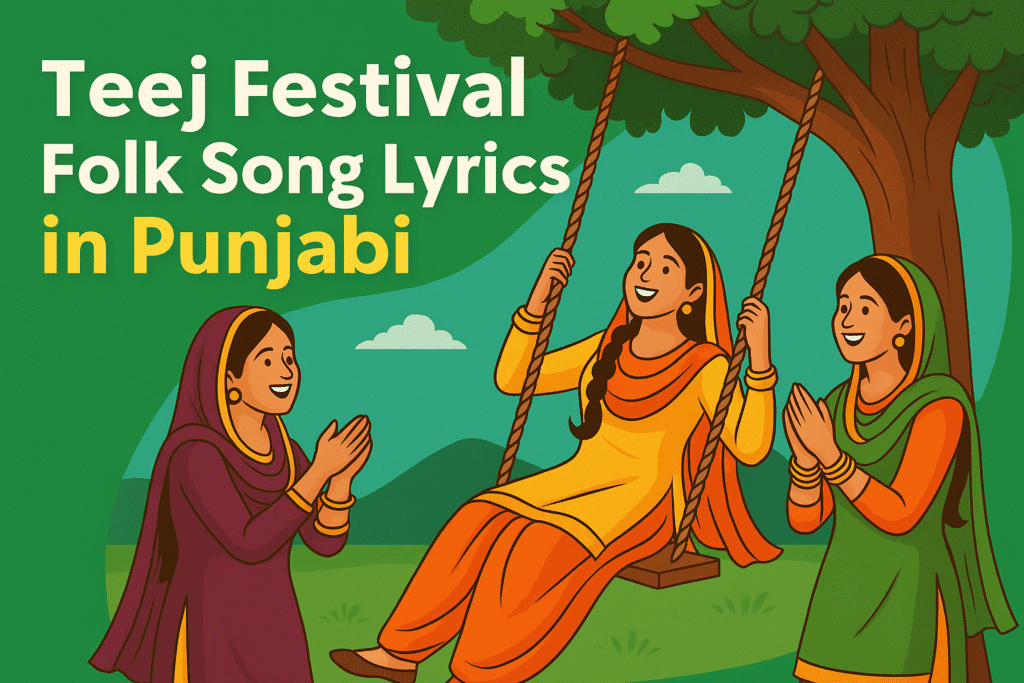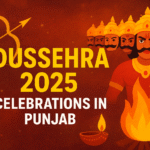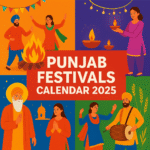Teej, celebrated in the month of Sawan, is one of Punjab’s most vibrant festivals. It symbolizes love, fertility, rain, and womanhood — celebrated with swings, mehndi, phulkari suits, and Giddha.
What truly brings Teej to life is the folk music – especially the boliyan (couplets) sung during Giddha performances.
In this blog, we present a popular traditional Punjabi Teej song complete with:
- Full lyrics in Gurmukhi
- Romanized Punjabi (English letters)
- English translation and cultural meaning
Traditional Punjabi Teej Song – Full Lyrics
🎵 Gurmukhi (Punjabi)
ਝੂਲਾ ਪਾ ਲਿਆਂ ਮੈ ਸਾਵਣ ਦੀਆਂ ਰੁੱਤਾਂ ’ਚ
ਬੀਬੀ ਤੇ ਭੈਣਾਂ ਦੀਆਂ ਹੱਸਦੀਆਂ ਮੁਟਿਆਰਾਂ ’ਚ
ਰੰਗ ਬਰਸੇ ਲਾਲੀ ਰੰਗ ਵੇ, ਲਗੇ ਸੋਹਣੀਆਂ ਯਾਰਾਂ ਨੂੰ
ਸਾਡੀ ਸਾਸ ਸਜਾਏ ਝੂਲਾ, ਲਾਵੇ ਸਗਣ ਦੀਆਂ ਧਾਰਾਂ ਨੂੰਚੰਨ ਵੀ ਚੜ੍ਹਿਆ ਅਸਮਾਨੀ ਵੇ, ਤੀਜ ਦੀ ਰਾਤ ਨੁਮਾਈ
ਸੂਟ ਨਵੇਂ ਪਾਈਏ ਪਹਿਰਾਵੇ, ਪੈਜਾਮੀ ਲਾਲ ਨਿਕਾਈਮਿੱਤਰਾਂ ਨੇ ਲਿਆਇਆ ਝੂਲਾ, ਫੁੱਲਾਂ ਨਾਲ ਸਜਾਇਆ
ਮੈਹੰਦੀ ਲਾਈ ਹਥੀਂ ਵੇ, ਰੂਪ ਨਿਕਰ ਕੇ ਆਇਆ
Romanized Punjabi (English Transliteration)
Jhoola pa liaa’n main sawan diya’n ruttan ‘ch
Bibi te bhainaan diya’n hasdiyan mutiyaaraan ‘ch
Rang barse laali rang ve, lage sohnian yaaraan nu
Saadi saas sajaave jhoola, laave sagan diya’n dhaaraan nuChann vi charria asmaani ve, Teej di raat numaayi
Suit navein paiye pehrave, paijaami laal nikaayiMittaraan ne liaaya jhoola, phullan naal sajaaya
Mehndi laayi hathin ve, roop nikar ke aaya
English Meaning / Translation
I’ve hung the swing during the monsoon rains,
Among smiling sisters and graceful young women.
Red color rains down with joy, making our beloveds fall in love,
My mother-in-law decorated the swing, and poured blessings for good fortune.The moon too has risen in the sky, shining on Teej night,
We wear brand-new outfits, red pajamas glowing bright.Friends brought a floral swing, decorated with blooms,
Mehndi (henna) graces our hands, and our beauty blooms in full.
Cultural Significance of the Song
This folk song captures the essence of Sawan Teej in Punjab:
- Swings: A major symbol of joy, tied to mango trees or verandahs
- Mehndi: Applied by young girls and brides, symbolizing love
- Mother-in-law & friends: Represent traditional family relationships in Teej
- Moon imagery: Adds romance and femininity to the Teej night
- New clothes & red color: Denote celebration and fertility
🪔 This song is commonly performed during Giddha dances at Teej Melas, school functions, and family gatherings.
How to Use This Song for Performances
| Idea | Usage |
|---|---|
| Giddha Dance | Best for 6–8 performers in traditional suits |
| Short Video Reels | Background for Teej celebration clips |
| School Function | Recite + dance with Rangoli & swing props |
| Wedding Functions | Part of “ladies sangeet” night for Punjabi flair |
| Cultural YouTube Shorts | With visuals of rural Punjab |
Add dholki beats or acoustic tumbi for live stage effect 🎶
FAQs About Punjabi Teej Songs
Q1. Is this a traditional song or newly written?
This is a traditional folk Teej song, commonly sung in rural and urban Punjab during Giddha performances.
Q2. Can school kids use this song?
Absolutely! It’s perfect for school and college events, and can be shortened for 2–3 minute performances.
Q3. Are there more Teej songs in Punjabi?
Yes, many boliyan and folk songs are passed down orally. Examples: “Sawan Aya, Jhoola Laya” and “Mehndi Layi Mai Haathan Vich”.
Q4. Where can I find an audio version?
You can search on YouTube or Punjabi music platforms. Look for “Teej Punjabi Giddha Song” or use our upcoming YouTube playlist.
Q5. Can I create a modern remix of this song?
Yes! Many creators remix folk songs with lo-fi beats, tumbi loops, and Punjabi rap. Just be sure to credit the folk roots.
🏁 Final Thoughts
Songs like these form the heartbeat of Punjabi festivals. In every word, rhythm, and clap, they capture the spirit of womanhood, monsoon joy, and family traditions.
🧵 Use this Teej song at your next event to keep our beautiful Punjabi culture alive and celebrated.







